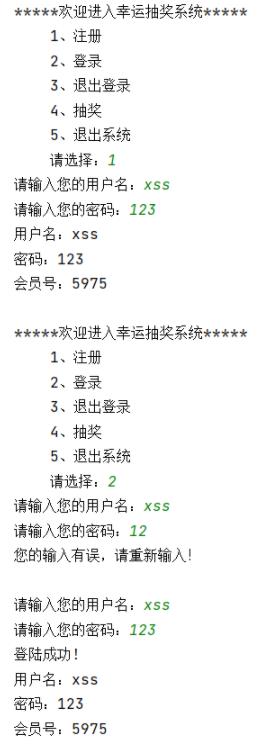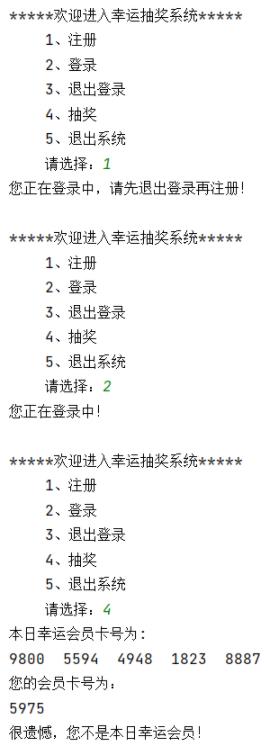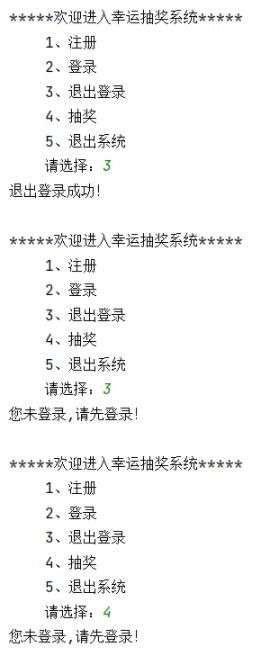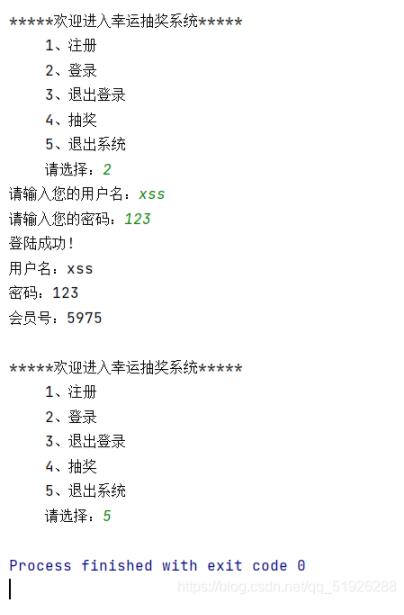How to implement lucky draw function in java
1. Task
Simulate the whole process of registration and login lucky draw
2. Main functions:
1.Registration
2.Login
3. Log out
4.Lottery
5.Log out of the system
Homepage:
1.Output menu
2.Select menu number
3. If the wrong number is selected, "Your input is wrong!" will be output.
Registration:
1. Enter the user name and password, and the system will generate a 4-digit random number as card number.
2. Registration is successful, output user information
Login:
1. Enter the user name and password used during registration, the login is successful, and the system prompts that the login is successful.
2. If the username and password are entered incorrectly, prompt the user to continue inputting.
Log out:
1. If the user is logged in, log out
2. If the user is not logged in, it will show that you are not logged in,
Lottery:
1. Enter the membership card number, and the system will generate 5 4-digit random numbers as lucky numbers
2. If the membership card number is one of them, you will become a lucky member today ; Otherwise, you are not a lucky member
Exit the system:
If the user wants to end the use of this system, he can exit the system and end the program.
Code implementation:
import java.util.Scanner;
class User{//用户
String name;
String password;
int cardid;
User(String name,String password){
this.name=name;
this.password=password;
cardid=(int)(Math.random()*9000+1000);
}
String getName(){
return name;
}
String getPassword(){
return password;
}
int getCardid(){
return cardid;
}
}
public class Lottery {//抽奖系统
public static void main(String[] args) {//main方法
User[]user=new User[10];
int total=0;//注册人数
int j=0;//是否退出系统
int x=0;//登录状态,默认未登录
int y=-1;//当前登录用户元素
do {
System.out.println("*****欢迎进入幸运抽奖系统*****");
System.out.println("\t1、注册");
System.out.println("\t2、登录");
System.out.println("\t3、退出登录");
System.out.println("\t4、抽奖");
System.out.println("\t5、退出系统");
System.out.print("\t请选择:");
int choice;
Scanner reader=new Scanner(System.in);
choice=reader.nextInt();
switch (choice){
case 1:
if (x==0)
total = getTotal(user, total);
else
System.out.println("您正在登录中,请先退出登录再注册!\n");
break;
case 2:
if (x==0) {
int i = 0;
do {
y = toLogin(user, total);
if (y==-1) {
System.out.println("您的输入有误,请重新输入!\n");
i = 1;
}else {
x = 1;
i=0;
}
} while (i == 1);
}else
System.out.println("您正在登录中!\n");
break;
case 3:
if (x==1){
x=0;
System.out.println("退出登录成功!\n");
}else
System.out.println("您未登录,请先登录!\n");
break;
case 4:
if (x==1){
toLottery(user, y);
}else
System.out.println("您未登录,请先登录!\n");
break;
case 5:
j=1;
break;
default:
System.out.println("您的输出有误,请重新输入!\n");
}
}while(j!=1);
}
private static void toLottery(User[] user, int y) {//抽奖方法
int j=0;
System.out.println("本日幸运会员卡号为:");
int cardid[]=new int[5];
cardid[0]=(int)(Math.random()*9000+1000);
cardid[1]=(int)(Math.random()*9000+1000);
cardid[2]=(int)(Math.random()*9000+1000);
cardid[3]=(int)(Math.random()*9000+1000);
cardid[4]=(int)(Math.random()*9000+1000);
for (int i=0;i<5;i++){
System.out.print(cardid[i]+" ");
if(user[y].getCardid()==cardid[i]){
j=1;
}
}
System.out.println("\n您的会员卡号为:\n"+user[y].getCardid());
if (j==1)
System.out.println("恭喜您,成为本日的幸运会员!\n");
else
System.out.println("很遗憾,您不是本日幸运会员!\n");
}
private static int toLogin(User[] user, int total) {//登录方法
Scanner reader=new Scanner(System.in);
System.out.print("请输入您的用户名:");
String name= reader.nextLine();
System.out.print("请输入您的密码:");
String password= reader.nextLine();
int j=-1;
for (int i = 0; i< total; i++) {
if (name.equals(user[i].getName())) {
if (password.equals(user[i].getPassword())) {
System.out.println("登陆成功!");
System.out.println("用户名:"+name+"\n密码:"+password+"\n会员号:"+user[i].getCardid()+"\n");
j=i;
}
}
}
return j;
}
private static int getTotal(User[] user, int total) {//注册方法
Scanner reader=new Scanner(System.in);
System.out.print("请输入您的用户名:");
String name= reader.nextLine();
System.out.print("请输入您的密码:");
String password= reader.nextLine();
for (int i=0;i<total;i++) {
if (name.equals(user[i].getName())) {
System.out.println("用户名已存在,请重新输入!\n");
return total;
}
}
user[total]=new User(name,password);
System.out.println("用户名:"+name+"\n密码:"+password+"\n会员号:"+user[total].getCardid()+"\n");
total++;
return total;
}
}


 ##
##
The above is the detailed content of How to implement lucky draw function in java. For more information, please follow other related articles on the PHP Chinese website!

Hot AI Tools

Undresser.AI Undress
AI-powered app for creating realistic nude photos

AI Clothes Remover
Online AI tool for removing clothes from photos.

Undress AI Tool
Undress images for free

Clothoff.io
AI clothes remover

AI Hentai Generator
Generate AI Hentai for free.

Hot Article

Hot Tools

Notepad++7.3.1
Easy-to-use and free code editor

SublimeText3 Chinese version
Chinese version, very easy to use

Zend Studio 13.0.1
Powerful PHP integrated development environment

Dreamweaver CS6
Visual web development tools

SublimeText3 Mac version
God-level code editing software (SublimeText3)

Hot Topics
 1377
1377
 52
52
 Perfect Number in Java
Aug 30, 2024 pm 04:28 PM
Perfect Number in Java
Aug 30, 2024 pm 04:28 PM
Guide to Perfect Number in Java. Here we discuss the Definition, How to check Perfect number in Java?, examples with code implementation.
 Random Number Generator in Java
Aug 30, 2024 pm 04:27 PM
Random Number Generator in Java
Aug 30, 2024 pm 04:27 PM
Guide to Random Number Generator in Java. Here we discuss Functions in Java with examples and two different Generators with ther examples.
 Weka in Java
Aug 30, 2024 pm 04:28 PM
Weka in Java
Aug 30, 2024 pm 04:28 PM
Guide to Weka in Java. Here we discuss the Introduction, how to use weka java, the type of platform, and advantages with examples.
 Smith Number in Java
Aug 30, 2024 pm 04:28 PM
Smith Number in Java
Aug 30, 2024 pm 04:28 PM
Guide to Smith Number in Java. Here we discuss the Definition, How to check smith number in Java? example with code implementation.
 Java Spring Interview Questions
Aug 30, 2024 pm 04:29 PM
Java Spring Interview Questions
Aug 30, 2024 pm 04:29 PM
In this article, we have kept the most asked Java Spring Interview Questions with their detailed answers. So that you can crack the interview.
 Break or return from Java 8 stream forEach?
Feb 07, 2025 pm 12:09 PM
Break or return from Java 8 stream forEach?
Feb 07, 2025 pm 12:09 PM
Java 8 introduces the Stream API, providing a powerful and expressive way to process data collections. However, a common question when using Stream is: How to break or return from a forEach operation? Traditional loops allow for early interruption or return, but Stream's forEach method does not directly support this method. This article will explain the reasons and explore alternative methods for implementing premature termination in Stream processing systems. Further reading: Java Stream API improvements Understand Stream forEach The forEach method is a terminal operation that performs one operation on each element in the Stream. Its design intention is
 TimeStamp to Date in Java
Aug 30, 2024 pm 04:28 PM
TimeStamp to Date in Java
Aug 30, 2024 pm 04:28 PM
Guide to TimeStamp to Date in Java. Here we also discuss the introduction and how to convert timestamp to date in java along with examples.
 Create the Future: Java Programming for Absolute Beginners
Oct 13, 2024 pm 01:32 PM
Create the Future: Java Programming for Absolute Beginners
Oct 13, 2024 pm 01:32 PM
Java is a popular programming language that can be learned by both beginners and experienced developers. This tutorial starts with basic concepts and progresses through advanced topics. After installing the Java Development Kit, you can practice programming by creating a simple "Hello, World!" program. After you understand the code, use the command prompt to compile and run the program, and "Hello, World!" will be output on the console. Learning Java starts your programming journey, and as your mastery deepens, you can create more complex applications.




